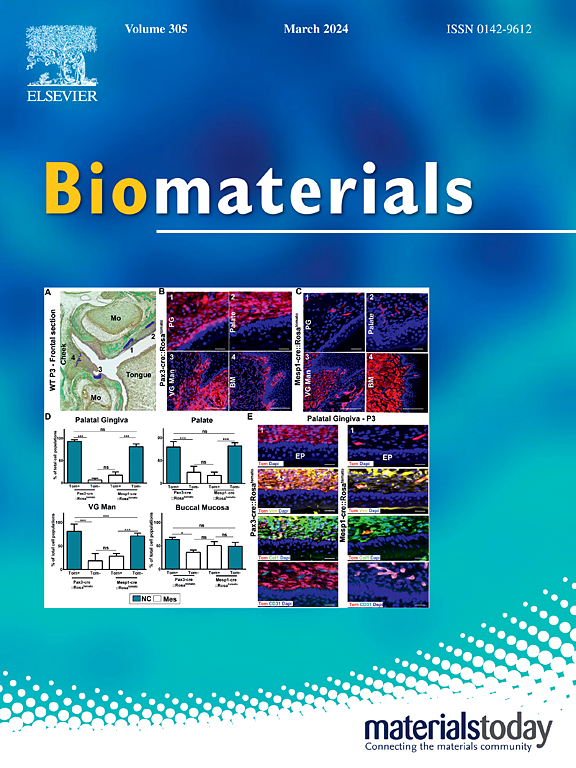Novel “hot spring”-mimetic scaffolds for sequential neurovascular network reconstruction and osteoporosis reversion
IF 12.8
1区 医学
Q1 ENGINEERING, BIOMEDICAL
引用次数: 0
Abstract
Neurovascular network damage and excessive hydrogen peroxide (H2O2) accumulation are the main obstacles for osteoporotic bone defect repair. It is extremely essential to endow the implants with sequential neuroangiogenesis promotion and osteoporosis pathological microenvironment improvement. Hot springs exhibits excellent facilitation on angiogenesis and bone regeneration due to abundant minerals, trace elements and modest thermal stimulation. Inspired by the hot spring effect, we propose a novel porous photothermal calcium magnesium phosphate bone cement (MCPC) compounded with manganese-substituted Fe3O4 (MnxFe3-xO4), which is perfused by temperature-responsive PLGA hydrogel loaded with vascular endothelial growth factor (VEGF) and nerve growth factor (NGF). At the initial stage of implantation, MnxFe3-xO4 scavenges excessive H2O2 under the heat stimulation triggered by near-infrared (NIR) light, and the factors are released from the hydrogel that stimulate the impaired neurovascular network reconstruction; at the later stage, the continuous hot spring effect maintains mild thermal stimulation and sustained release of bioactive ions (Ca2+, Mn2+, Mg2+ and PO43−), which inhibits osteoclast function and activity, and promotes osteogenic differentiation and mineralization. The osteoporotic bone defect model in ovariectomized (OVX) rats further verifies that a synergy effect of photothermal therapy and bioactive factors/ions significantly promotes neurovascular bone regeneration. It demonstrates that the hot spring mimetic effect possesses huge potential for the sequential treatment of osteoporosis bone defect.

求助全文
约1分钟内获得全文
求助全文
来源期刊

Biomaterials
工程技术-材料科学:生物材料
CiteScore
26.00
自引率
2.90%
发文量
565
审稿时长
46 days
期刊介绍:
Biomaterials is an international journal covering the science and clinical application of biomaterials. A biomaterial is now defined as a substance that has been engineered to take a form which, alone or as part of a complex system, is used to direct, by control of interactions with components of living systems, the course of any therapeutic or diagnostic procedure. It is the aim of the journal to provide a peer-reviewed forum for the publication of original papers and authoritative review and opinion papers dealing with the most important issues facing the use of biomaterials in clinical practice. The scope of the journal covers the wide range of physical, biological and chemical sciences that underpin the design of biomaterials and the clinical disciplines in which they are used. These sciences include polymer synthesis and characterization, drug and gene vector design, the biology of the host response, immunology and toxicology and self assembly at the nanoscale. Clinical applications include the therapies of medical technology and regenerative medicine in all clinical disciplines, and diagnostic systems that reply on innovative contrast and sensing agents. The journal is relevant to areas such as cancer diagnosis and therapy, implantable devices, drug delivery systems, gene vectors, bionanotechnology and tissue engineering.
 求助内容:
求助内容: 应助结果提醒方式:
应助结果提醒方式:


